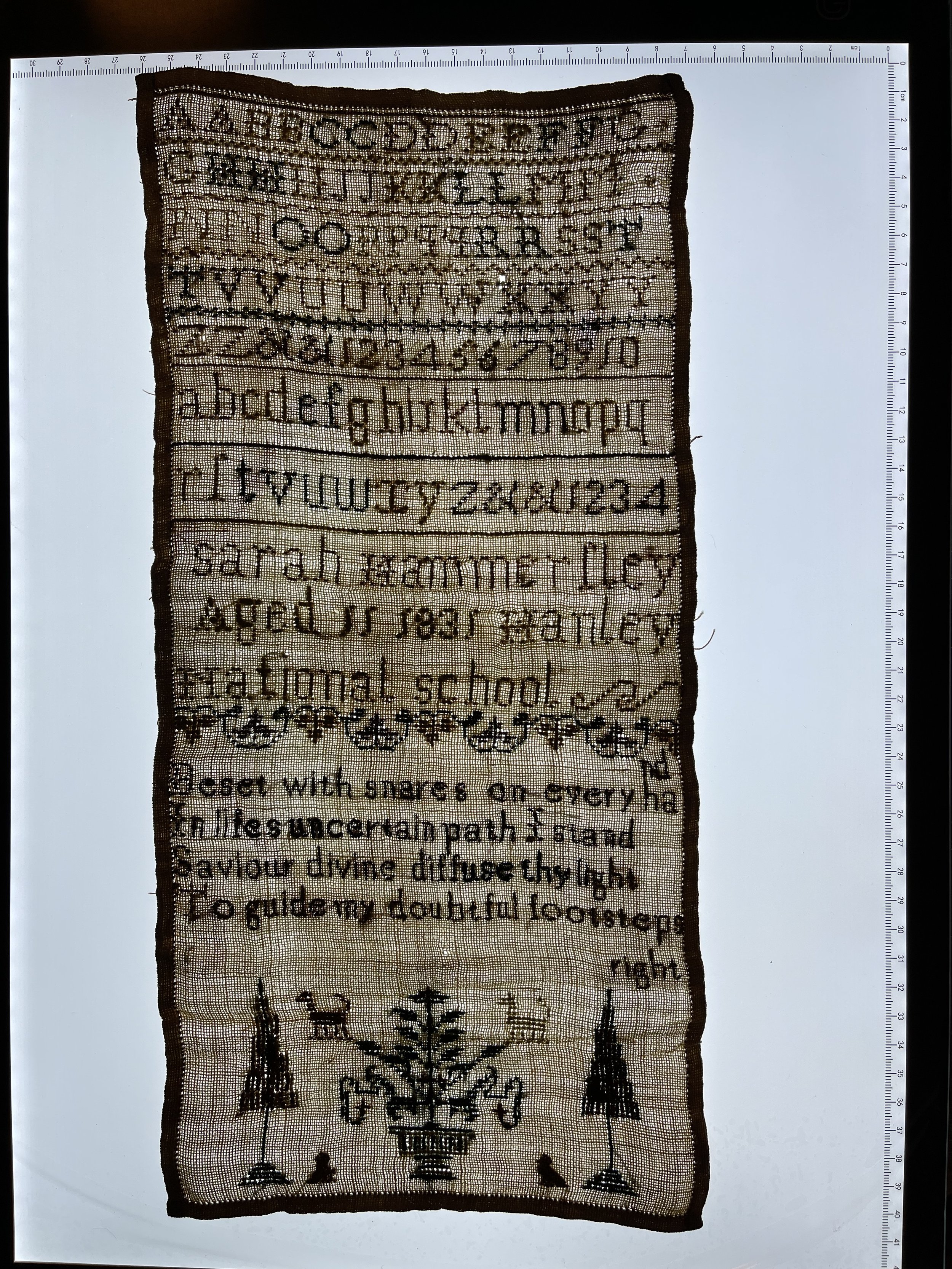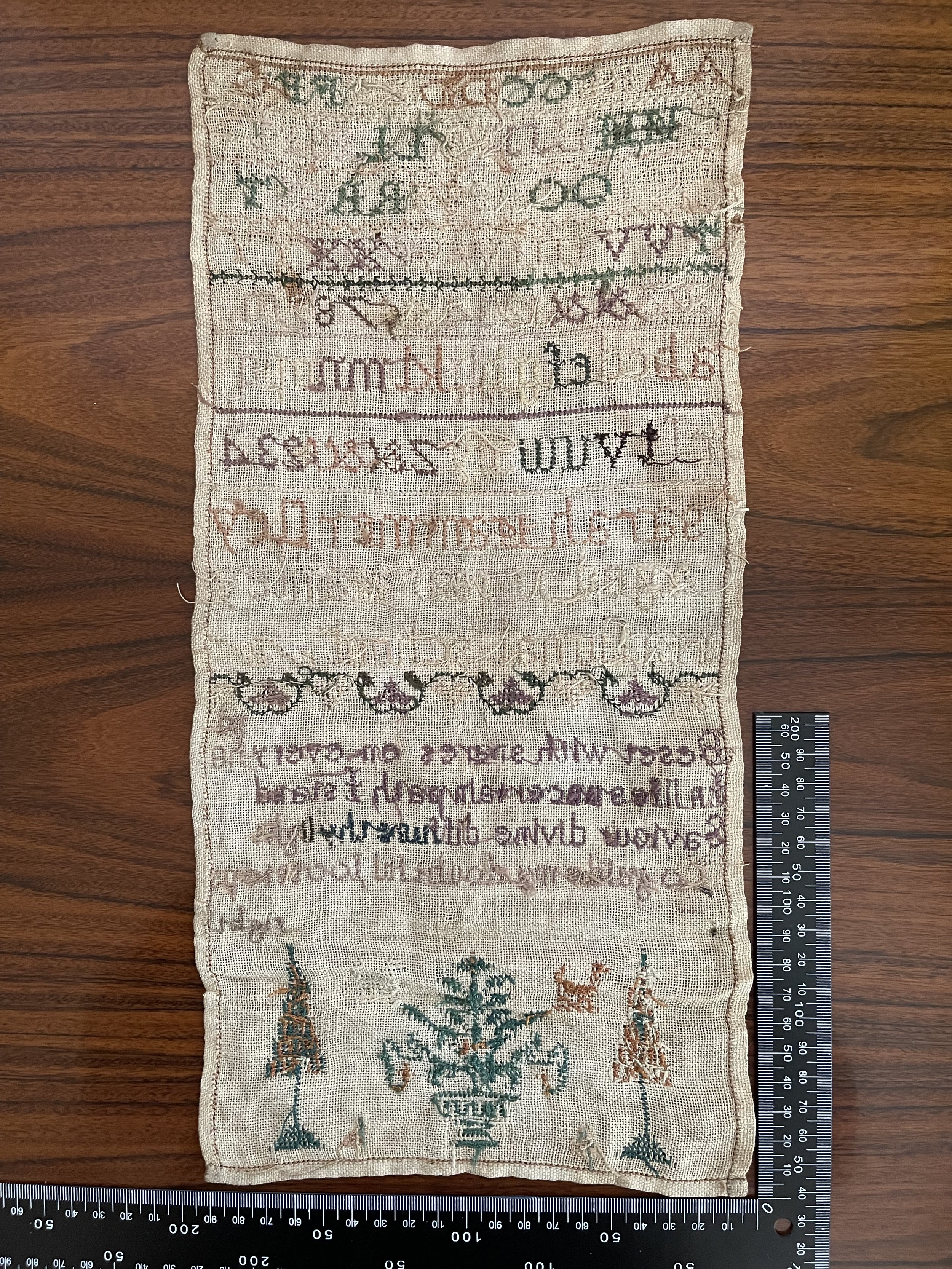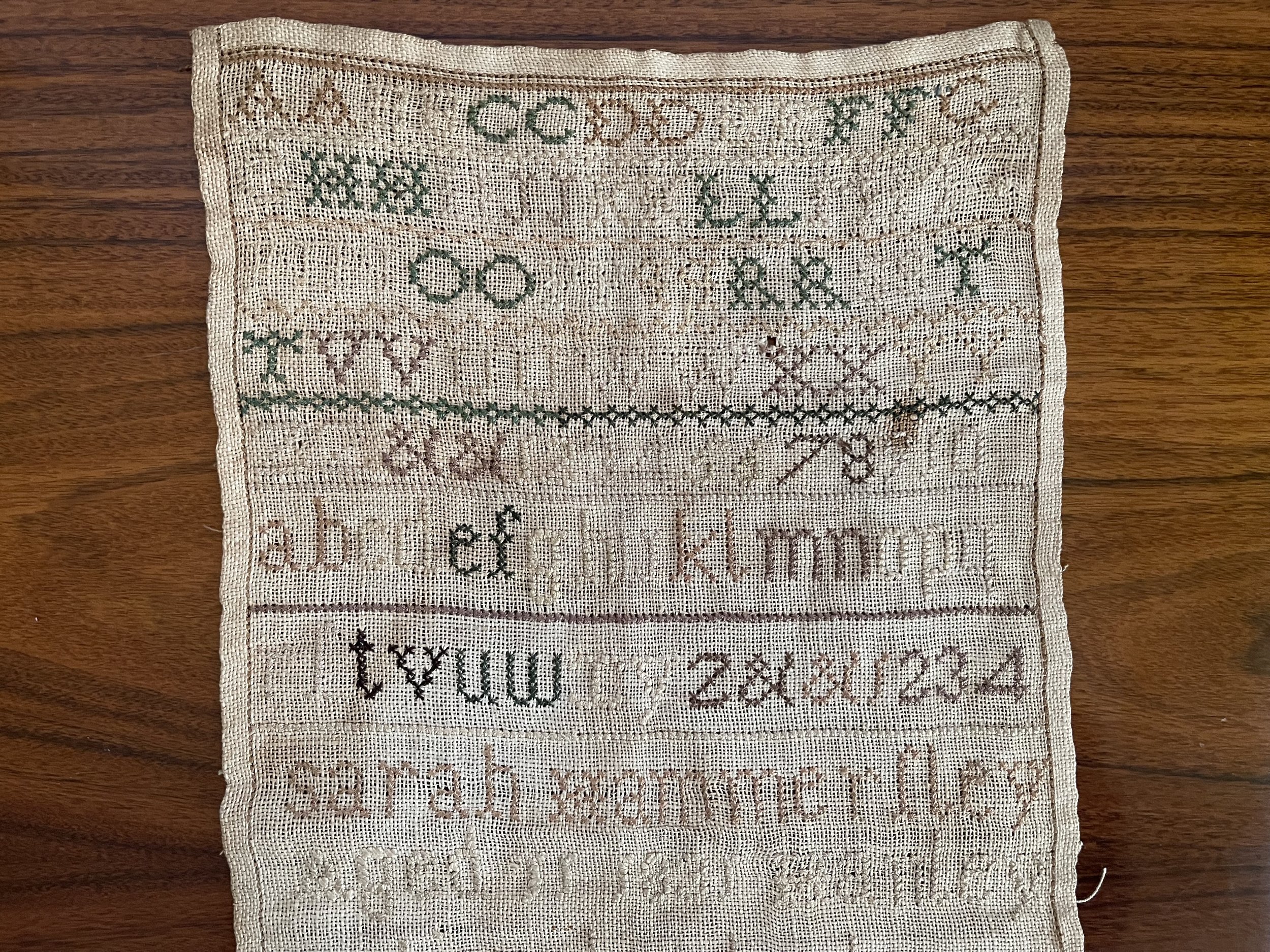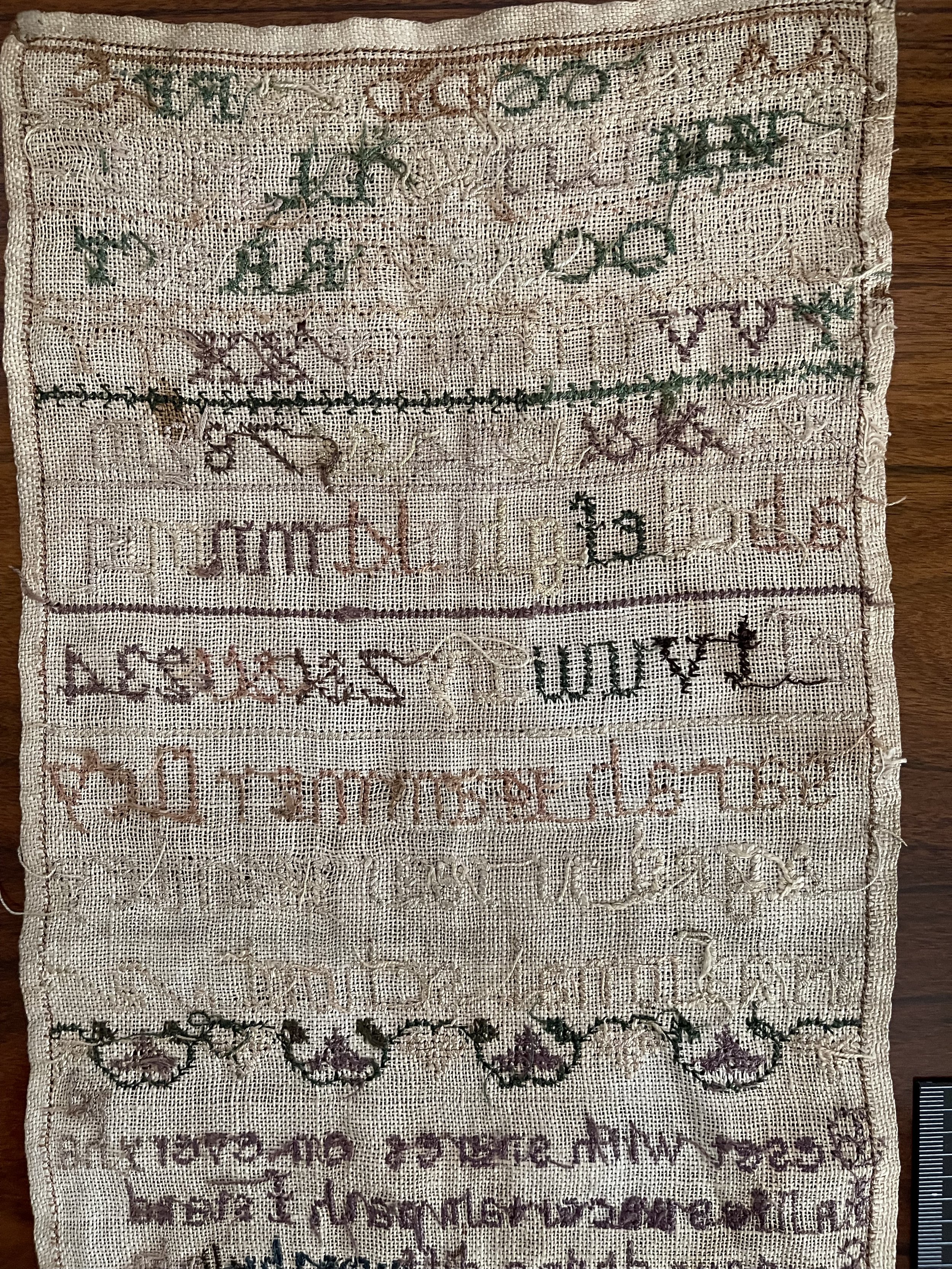Alphabet Sampler - Sarah Hammersley - Aged 11 - Hanley National School (Possibly Stoke on Trent) - Dated 1831
Alphabet Sampler - Sarah Hammersley - Aged 11 - Hanley National School - 1831
Samplers have become very collectible and increasingly valuable to the collector. Traditional ABC samplers date back to 18th century orphanages where children learned cross stitch to practice stitches and alphabets and to acquire household skills that would be useful in service.
During the 1700s, samplers depicting alphabets and numerals were worked by young women to learn the basic needlework skills needed to operate the family household. By the late 1700s and early 1800s, schools or academies for well-to-do young women flourished, and more elaborate pieces with decorative motifs such as verses, flowers, houses, religious, pastoral, and/or mourning scenes were being stitched. The parents of these young women proudly displayed their embroideries as showpieces of their work, talent, and status.
In recent years, many of these samplers have been lost and have become important in museum collections as representations of early female education. Many are signed, and some are inscribed with locations and the names of teachers and schools. The emergence of these samplers has resulted in much research in diaries, account books, letters, newspaper ads, local histories, and published commentary that is helping to illuminate the lives of women.
Many early samplers do not have the letters “J” and “U” in their alphabets because they were not part of the early Latin alphabet and so the letter “I” was used for “J” and the “V” for “U.” The letter “s” is often replaced with the printer’s “s” which looks like the modern f.
Early samplers were stitched in wool, cotton or linen ( and occasionally silk) thread on plain linen. The colours are muted because they were produced using vegetable dyes, which fade or smudge over time. Later ones used commercially dyed threads.
Until the mid-1800s, all dyes came from natural sources, such as insects, roots, or minerals. Producing them was difficult and expensive. In 1856, an 18-year-old English chemist, William Henry Perkin, accidentally discovered one of the first synthetic dyes.
Cochineal was a favourite dye for red, scarlet, crimson, and oranges until about 1850 when synthetic reds were invented. Cochineal was a favourite because of its colourfastness, intense colour, and ease to process and work. During the eighteenth century, indigo was known as a universal source of blue, but there were different varieties.
Elementary Education before 1870 – Stoke-on-Trent - Hanley National School
During the earlier 19th century, the educational facilities offered by the endowed schools began to be supplemented by schools founded by the various churches and the two schools' societies, the National Society and the British and Foreign Schools Society. The first such school to be founded was the Wesleyan Day School in Burslem in 1814, followed there by a National School in 1817 in connection with St. John's Church.
National Schools were founded in Stoke in 1815 and in Hanley in 1816. In Hanley the National School was quickly followed by a nonconformist school, the British School in Pall Mall, founded by the Ridgway family, who were leaders of the Methodist New Connexion in the area. Longton (St. John's) National School was founded in 1822 and St. James's National School in 1836, but Tunstall and Fenton National Schools were not founded until 1839. By 1850 thirteen National Schools had been established in the various Pottery towns and there was a parish school at Bucknall. In Stoke itself the Church of England was particularly active in this matter. Apart from the main National School, attached to St. Peter's Church, schools had by 1850 been founded at Hartshill, Trent Vale, and Penkhull. There were also two Wesleyan schools, one unsectarian school, one British school, and two Roman Catholic schools in the Potteries area by 1851. Many of these schools owed their existence, not to the churches, but to individuals who promoted them and largely maintained them. Such were the British School for boys at Hanley (founded 1819) supported by the Ridgway family, the unsectarian school at Etruria (founded 1846) maintained by the Wedgwood family, particularly Francis Wedgwood, (fn. 52) and the National Schools in Stoke, Longton, and Hanley which benefited by a bequest of £3,000 by J. C. Woodhouse, Dean of Lichfield and formerly Rector of Stoke.
Alphabet Sampler - Sarah Hammersley - Aged 11 - Hanley National School - 1831
Samplers have become very collectible and increasingly valuable to the collector. Traditional ABC samplers date back to 18th century orphanages where children learned cross stitch to practice stitches and alphabets and to acquire household skills that would be useful in service.
During the 1700s, samplers depicting alphabets and numerals were worked by young women to learn the basic needlework skills needed to operate the family household. By the late 1700s and early 1800s, schools or academies for well-to-do young women flourished, and more elaborate pieces with decorative motifs such as verses, flowers, houses, religious, pastoral, and/or mourning scenes were being stitched. The parents of these young women proudly displayed their embroideries as showpieces of their work, talent, and status.
In recent years, many of these samplers have been lost and have become important in museum collections as representations of early female education. Many are signed, and some are inscribed with locations and the names of teachers and schools. The emergence of these samplers has resulted in much research in diaries, account books, letters, newspaper ads, local histories, and published commentary that is helping to illuminate the lives of women.
Many early samplers do not have the letters “J” and “U” in their alphabets because they were not part of the early Latin alphabet and so the letter “I” was used for “J” and the “V” for “U.” The letter “s” is often replaced with the printer’s “s” which looks like the modern f.
Early samplers were stitched in wool, cotton or linen ( and occasionally silk) thread on plain linen. The colours are muted because they were produced using vegetable dyes, which fade or smudge over time. Later ones used commercially dyed threads.
Until the mid-1800s, all dyes came from natural sources, such as insects, roots, or minerals. Producing them was difficult and expensive. In 1856, an 18-year-old English chemist, William Henry Perkin, accidentally discovered one of the first synthetic dyes.
Cochineal was a favourite dye for red, scarlet, crimson, and oranges until about 1850 when synthetic reds were invented. Cochineal was a favourite because of its colourfastness, intense colour, and ease to process and work. During the eighteenth century, indigo was known as a universal source of blue, but there were different varieties.
Elementary Education before 1870 – Stoke-on-Trent - Hanley National School
During the earlier 19th century, the educational facilities offered by the endowed schools began to be supplemented by schools founded by the various churches and the two schools' societies, the National Society and the British and Foreign Schools Society. The first such school to be founded was the Wesleyan Day School in Burslem in 1814, followed there by a National School in 1817 in connection with St. John's Church.
National Schools were founded in Stoke in 1815 and in Hanley in 1816. In Hanley the National School was quickly followed by a nonconformist school, the British School in Pall Mall, founded by the Ridgway family, who were leaders of the Methodist New Connexion in the area. Longton (St. John's) National School was founded in 1822 and St. James's National School in 1836, but Tunstall and Fenton National Schools were not founded until 1839. By 1850 thirteen National Schools had been established in the various Pottery towns and there was a parish school at Bucknall. In Stoke itself the Church of England was particularly active in this matter. Apart from the main National School, attached to St. Peter's Church, schools had by 1850 been founded at Hartshill, Trent Vale, and Penkhull. There were also two Wesleyan schools, one unsectarian school, one British school, and two Roman Catholic schools in the Potteries area by 1851. Many of these schools owed their existence, not to the churches, but to individuals who promoted them and largely maintained them. Such were the British School for boys at Hanley (founded 1819) supported by the Ridgway family, the unsectarian school at Etruria (founded 1846) maintained by the Wedgwood family, particularly Francis Wedgwood, (fn. 52) and the National Schools in Stoke, Longton, and Hanley which benefited by a bequest of £3,000 by J. C. Woodhouse, Dean of Lichfield and formerly Rector of Stoke.
Alphabet Sampler - Sarah Hammersley - Aged 11 - Hanley National School - 1831
Samplers have become very collectible and increasingly valuable to the collector. Traditional ABC samplers date back to 18th century orphanages where children learned cross stitch to practice stitches and alphabets and to acquire household skills that would be useful in service.
During the 1700s, samplers depicting alphabets and numerals were worked by young women to learn the basic needlework skills needed to operate the family household. By the late 1700s and early 1800s, schools or academies for well-to-do young women flourished, and more elaborate pieces with decorative motifs such as verses, flowers, houses, religious, pastoral, and/or mourning scenes were being stitched. The parents of these young women proudly displayed their embroideries as showpieces of their work, talent, and status.
In recent years, many of these samplers have been lost and have become important in museum collections as representations of early female education. Many are signed, and some are inscribed with locations and the names of teachers and schools. The emergence of these samplers has resulted in much research in diaries, account books, letters, newspaper ads, local histories, and published commentary that is helping to illuminate the lives of women.
Many early samplers do not have the letters “J” and “U” in their alphabets because they were not part of the early Latin alphabet and so the letter “I” was used for “J” and the “V” for “U.” The letter “s” is often replaced with the printer’s “s” which looks like the modern f.
Early samplers were stitched in wool, cotton or linen ( and occasionally silk) thread on plain linen. The colours are muted because they were produced using vegetable dyes, which fade or smudge over time. Later ones used commercially dyed threads.
Until the mid-1800s, all dyes came from natural sources, such as insects, roots, or minerals. Producing them was difficult and expensive. In 1856, an 18-year-old English chemist, William Henry Perkin, accidentally discovered one of the first synthetic dyes.
Cochineal was a favourite dye for red, scarlet, crimson, and oranges until about 1850 when synthetic reds were invented. Cochineal was a favourite because of its colourfastness, intense colour, and ease to process and work. During the eighteenth century, indigo was known as a universal source of blue, but there were different varieties.
Elementary Education before 1870 – Stoke-on-Trent - Hanley National School
During the earlier 19th century, the educational facilities offered by the endowed schools began to be supplemented by schools founded by the various churches and the two schools' societies, the National Society and the British and Foreign Schools Society. The first such school to be founded was the Wesleyan Day School in Burslem in 1814, followed there by a National School in 1817 in connection with St. John's Church.
National Schools were founded in Stoke in 1815 and in Hanley in 1816. In Hanley the National School was quickly followed by a nonconformist school, the British School in Pall Mall, founded by the Ridgway family, who were leaders of the Methodist New Connexion in the area. Longton (St. John's) National School was founded in 1822 and St. James's National School in 1836, but Tunstall and Fenton National Schools were not founded until 1839. By 1850 thirteen National Schools had been established in the various Pottery towns and there was a parish school at Bucknall. In Stoke itself the Church of England was particularly active in this matter. Apart from the main National School, attached to St. Peter's Church, schools had by 1850 been founded at Hartshill, Trent Vale, and Penkhull. There were also two Wesleyan schools, one unsectarian school, one British school, and two Roman Catholic schools in the Potteries area by 1851. Many of these schools owed their existence, not to the churches, but to individuals who promoted them and largely maintained them. Such were the British School for boys at Hanley (founded 1819) supported by the Ridgway family, the unsectarian school at Etruria (founded 1846) maintained by the Wedgwood family, particularly Francis Wedgwood, (fn. 52) and the National Schools in Stoke, Longton, and Hanley which benefited by a bequest of £3,000 by J. C. Woodhouse, Dean of Lichfield and formerly Rector of Stoke.
Code : A634
Cartographer : Cartographer / Engraver / Publisher: Sarah Hammersley - Aged 11 - Hanley National School
Date : Publication Place / Date - 1831
Size : Sheet size: Image Size: 40 by 19.5 cms.
Availability : Available
Type - Genuine - Antique
Grading A-
Where Applicable - Folds as issued. Light box photo shows the folio leaf centre margin hinge ‘glue’, this is not visible otherwise.
Tracked postage, in casement. Please contact me for postal quotation outside of the UK.







